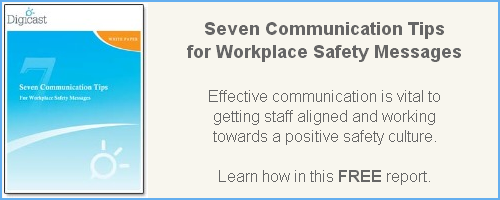As mentioned in " How to Develop a Workplace Safety Messages Campaign" Part 1, marketing is the key to getting your safety messages heard and understood.
7 Steps to Writing your Company's Safety Message
 If you're in charge of writing the next safety message or safety slogan for your company's safety initiatives, you know that you've got a challenge ahead of you. After all, most safety slogans become invisible and ineffective pretty quickly.
If you're in charge of writing the next safety message or safety slogan for your company's safety initiatives, you know that you've got a challenge ahead of you. After all, most safety slogans become invisible and ineffective pretty quickly.
Only create a safety message that is part of a workplace safety campaign where people receive training to change their behaviour. Otherwise. putting a poster on the wall with a new slogan is as helpful as putting a sticker on your car that says "Baby on board". No-one will pay much attention (or really care!).
In the book, Transform your Safety Communication, it goes through in lots of detail all of the steps to create a workplace safety message. If you want to get access to some safety communication fundamentals, download a free chapter here. Otherwise, let's go into some easy steps for creating a safety message.
To ensure your safety message is sticky, here are seven important tips:
1. Use positive language - Avoid creating a slogan that focuses on behaviour that you don't want. Instead, write a safety message that conveys what you want people to do. For example a negative slogan for height safety is "Don't fall for it". Using more positive language, a more appropriate version is "A harness is better than a hearse". While this might have negative connotations, it still focuses on what you want the person to do, rather than the wrong behaviour.
3. Keep it short (and tweet) - In this age of Twitter, being able to write in 140 characters or less helps you to distill your message. It's the same with writing a safety message, just try and encapsulate it in 12 words or less.
4. Avoid jargon - Make sure the sentence flows easily. Avoid acronyms and words that not everyone will understand (use the test: will my mum get this one?).
5. Contain a surprise - Common sense is the enemy of sticky safety messages. When our brain’s guessing machine fails, it wants to work out why it was unable to guess. This surprise grabs our attention, so that we can be prepared in the future. By trying to work out what went wrong, our brain is more likely to remember the information. Here's a good example (a personal fave):
Hug your kids at home, but belt them in the car.
Slogans that contain the obvious will be ignored Examples are: "Play it safe" and "Be aware, take care". Yawn!
 6. Use visuals - Incorporating visuals with your safety message is a powerful way to get the message across. The visual needs to increase understanding, not detract. Here's a good example.
6. Use visuals - Incorporating visuals with your safety message is a powerful way to get the message across. The visual needs to increase understanding, not detract. Here's a good example.
Note that the image shows the right behaviour and the text is located close to the image, so the brain can easily identify what the poster is about (learn more about using visuals at Why using Visuals is so Important). It's also part of a manual handling training campaign where staff went through extensive training.
And for potential copyright reasons, we can't show you any bad posters. But they're pretty easy to find!
2. Use metaphors - Metaphors are a powerful way to get people to understand and remember information. In the book, Made to Stick by Chip and Dan Heath, they mention that sticky messages are often metaphors in disguise. Metaphors are about understanding one thing in terms of something else. An example would be for stair safety. Did you know that more people die each year from falling from stairs than they do from being attacked by a shark?
7. Play on words - A clever play on words helps to make your safety message just that little bit more memorable. This can include rhyming and repeating words in a different order. Adding a little bit of fun can make a serious subject more approachable. You can see a longer list at 29 Top Catchy Safety Slogans.
Is better to lose one minute in life... than to lose life in a minute.
Know safety, no injury. No safety, know injury
Lifting's a breeze when you bend at the knees
Once you have created you safety slogan and trained people on the new behaviour that is required, regularly remind staff of the safety message in toolbox meetings and email newsletters etc. The more people frequently see it, the more it will get remembered.

